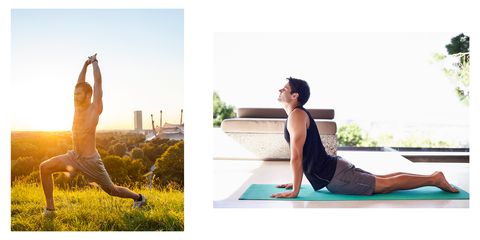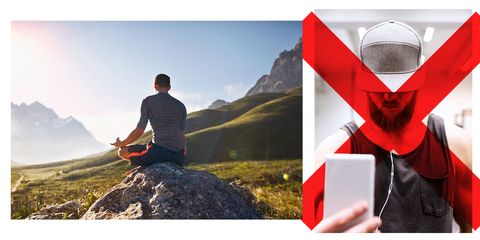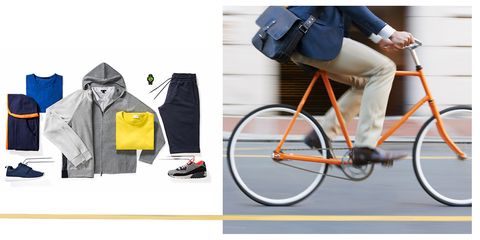The Only Self-Care Strategy You'll Ever Need
There are some things you make time for no matter what. Sunday football with the guys. Your upcoming anniversary dinner. But what about self-care? Forget the notion of bubble baths and booking massages: A self-care practice that complements your lifestyle can effectively help you get the most out of your day. That’s because your mind and body are the center of everything you do (but you already know that, right?)—think of self-care as your recharge. Clearing your head on the drive during your daily commute? That counts.
What your own regimen looks like will differ from the next person based on a few factors, including how you train. Someone who’s all about marathoning may occupy a different mental space than the one trying to build muscle by the squat rack. Whether you’re an endurance junkie or a gym rat, here are practical ways to incorporate self-care into your regular routine for a more optimized lifestyle.
The Outdoors Athlete

Getty Images
Fresh air is calling his name. Whether it’s mountain biking or hanging ten, there’s no such thing as spending too much time with nature. He’s got a bike rack on his car screaming for use, and a list of mountains he wants to summit within the next five years at the ready.
Self-Care Strategy No. 1: Take a break.
When the world is your oyster, it’s easy to see the exciting adventure opportunity everywhere and anywhere, from your backyard to a highway rest stop. Sometimes, what your body really needs is simply rest. “Knowing when to rest your body and mind is an incredibly important part of maintaining a healthy routine,” says Dr. Brian Mikolasko, an internist at Icahn School of Medicine at Mount Sinai. “Without time to recover from sustained or intense activity, our bodies and minds cannot grow stronger from the positive stresses we put on them. Rather, excess exertion sets us up for mental fatigue and routine disrupting injuries. Even the most elite athletes know that achieving optimum performance requires a cycle with well-timed rest.”
Of course, intending to “rest” and actually resting are two different beasts. Find some sort of stretching routine that accommodates for the activities you’re doing most often, and set aside a specific amount of time (we suggest 15 minutes) right after you get out of bed on your day off. Here, Jeff Brannigan of New York City’s Stretch*d, a boutique studio dedicated to flexibility, offers three must-try movements for outdoor enthusiasts:
The Trap Tap (Targets: Trapezius)
Brannigan says: “Those traps can get extra worked when paddling, either out to catch the next wave or in a kayak. This stretch will help stretch out the trapezius and also help to relax the shoulders away from the ears (from all your desk-sitting).”
Do it: Stand or sit with your feet slightly apart and your arms at your sides. Lift one arm, with the elbow bent, and raise it across your chest over the opposite shoulder until your hand reaches down your back (like you’re giving yourself a well-deserved pat on the back). Use the other hand to give a gentle assist at the elbow at the end of the movement. Keep your torso still and resist the temptation to hike up your shoulder. Hold each tap for 2 to 3 seconds and release. Repeat 10 times for a full set.
Toes Up (Targets: Soleus, or your low to mid-calf)
Brannigan says: “Beach or trail running on more uneven and unpredictable surfaces (rocks, tree branches, sand, etc.) can easily tighten up the calves. Here’s a quick and easy way to loosen up those muscles (and say goodbye to random muscle cramping).”
Do it: Sit with one leg straight and the other leg bent at about a 90-degree angle. Keep the heel of the bent leg foot on the ground while you reach around for the sole of the foot with both hands. Flex the toes and foot upwards towards the chest. If you’re not able to reach the foot, use a towel or strap as assistance. Hold the stretch for 2 to 3 seconds for a set of 10. Repeat as needed.
Hands Behind the Head (Targets: Thoracic Lumbar Rotator)
Brannigan says: “If your mid or low back is sore from long bike rides, this stretch is great to find some extension and relief.”
Do it: Sit with your back straight and feet flat on the floor. Place your hands behind your head (you know the drill). Interlace your fingers with your elbows out. Rotate your upper body in one direction until you have twisted as far as you can go. When you feel loosened up (after 3 or 4 repetitions in one direction), rotate, hold and then dip down and bring your elbow towards the outside of the same side knee. Return to an upright position. Work one side at a time, completing all repetitions (10 reps, for 2 to 3 second each) before beginning on the opposite side.

Mazda
Self-Care Strategy No. 2: Take a long drive.
When you’re outside, sometimes you have to surrender to the fact that not everything’s in your control. Maybe the day’s weather or the conditions on a trail you’re aiming to tackle aren’t ideal. That all fades away when you’re in the driver’s seat of the car: here, you’re in full control. But when it comes to reaching that meditative state on a long drive—the unmatched feeling of full control and seamless connection with the road—what you’re driving is more important than where you’re going (though twists, turns, and a constant, peacefully green canopy are nice ingredients for clearing your head and a sensible self-care move for anyone).
It’s why car companies like Mazda take driver ergonomics and dynamic engineering seriously. While exploring all the ways to design a better car and create a more optimal driving experience, “everything boiled down to the driving position,” says Tomonori Otsubo of Mazda’s Vehicle Testing & Research Department. Mazda engineers place utmost importance on human-centric design, so that the vehicle feels like an extension of your body. In the 2018 Mazda6, G-Vectoring Control technology makes steering more natural and accurate, available Dynamic Pressure Turbocharged SKYACTIV-G 2.5T engine improves responsiveness, and seats are designed to mimic and support your body’s posture, all making driving effortless for maximum “zen-den” effect.
The Endurance Junkie

Getty Images
He craves race bibs and keeps a stash of energy gel in his car’s glove compartment. No Saturday morning’s complete without at least 2 hours worth of cardio and a post-workout bagel splurge. Always with a 5K on the agenda, this athlete knows a thing or two about stamina.
Self-Care Strategy No. 1: Muscle TLC.
When you’re logging 40 to 50 miles a week running (nevertheless cycling or swimming), the muscles take a heavy hit. “Only when you recover from physical challenges are the true benefits of exercise attained,” says Rick Richey, co-founder of New York City’s first-ever recovery studio, ReCOVER. “When endurance athletes are logging a lot of miles the body becomes catabolic, or begins the process of breaking down. As recovery sets in, we move from a catabolic state into an anabolic state or a rebuilding state. This rebuilding state often reaches a peak that is above your previous baseline.”
A comprehensive foam rolling, stretching, and activation program is a great way to maintain neuromuscular efficiency, avoid injury, and continue making athletic progress as the brain maintains the ability to fire the right muscles at the right time. Aaron Drogoszewski, also of ReCOVER, suggests three different areas of concentration for 30 seconds each: foam rolling the tensor fascia latae (TFL), a kneeling runner’s lunge stretch, and glute bridges.

Getty Images
Self-Care Strategy No. 2: Find some zen with a yoga flow.
Not only is yoga an ideal way to give your muscles some TLC in between heavy lifting sessions, but it can also improve cardiovascular health and help greaten your sense of self esteem. “Yoga is one of the best ways we can take care of ourselves both physically and mentally,” says Austin Kapetanakis, teacher at Lyons Den Power Yoga in New York City. “It can help us be less reactive to the natural stressors of our daily lives, and reduce the mental stress and strain that endurance training and running events can put on the mind.”
Kapetanakis suggests giving those tight running hips a little extra love with the following three yoga poses:
Lizard Pose: From standing, step your right foot forward to a low runners lunge position. With your weight evenly distributed evenly between both hips, place both hands about shoulder width distance apart, in line on the inside of your right leg. Keep your chest lifted, and actively press your knee out toward the outer edge of your right foot. Hold for 12 breaths.
Half Pigeon Pose: Come onto your hands and knees on the floor. Bring your right knee as close to your right wrist as you can. Then work your right foot towards your left hand, and stretch your left leg and left foot straight back with the top of your left foot pressing into the floor. Relax your upper body forward and over your right shin towards the floor while stretching your arms out forward. Stay for 15 to 20 seconds; repeat on opposite side.
Frog Pose: Come on to all fours on your hands and knees. Begin to take your knees as wide apart as you can without straining. Press your heels out to bring the inner part of your foot to the floor. From here, create a 90 degree angle with your shins and thighs. Bring your hands or forearms to the floor to support your torso, then press your hips backwards towards your feet to deepen the stretch. Stay for 20 breaths.
The Gym Rat

Getty Images
He can’t get enough time in front of the dumbbell rack. In fact, he’s big into every single piece of equipment you can find in the gym. He’s got a bag packed for any opportunity to fraternize by barbells, and the woman at the facility’s smoothie bar knows his post-workout order, complete with a double-scoop of whey.
Self-Care Strategy No. 1: Meditate, meditate, meditate.
Ask almost any mega-successful CEO or athlete if they meditate (see: Kobe Bryant, Lebron James, Dave Asprey) and they’ll say yes. With good reason, too. Meditation can relieve headaches, lower your blood pressure, and help you get more out of your workout. Plus, just 30 minutes of meditation improves symptoms of depression, according to one Johns Hopkins University study.
Total newbies to the mindfulness game? Then ease into things, slowly. “The key element here is to be very honest with your schedule and make sure you integrate it into your routine at a time that best accommodates you taking 5 to 20 minutes off,” says Carla Hammond, longtime meditation practitioner and founder of Be Time, a mobile meditation studio. “Just like with allocating time for the gym, make sure you set yourself up so that it can become an easy new habit to stick to. Begin with 5 minutes at first, and then add on from there as you feel ready to.”

Getty Images
Self-Care Strategy No. 2: Use your cell phone…the right way.
Two things you’re almost guaranteed to see on the gym floor: someone grunting while lifting weights, and another guy filming his workout. Being overly concerned with how you look can trigger a physiological reaction that tightens muscles and upsets rhythm. Instead, switch your mindset to reap better-body benefits of recording your movement.
Maybe you’re experiencing a plateau in your progress or have had a weird feeling in your calf when you spend more than 2 minutes on the treadmill. Watching back footage of lifts (and even your stride) can help you identify discrepancies in your movement patterns, beat any plateaus you’ve been struggling with, and ultimately-protect against potential injury.
“I’ve been taking loads of video lately, specifically because it helps me clean up my form a ton,” says Men’s Health fitness editor Ebenezer Samuel, CSCS. “I can watch for little things like shoulder symmetry, not slipping into thoracic extension, and keeping my spine in alignment in a video much more easily than I can in a mirror.”
Samuel’s tip for snagging the footage? Just grab a water bottle, and press record. “I lean my phone up against my bottle for most exercises, and it gets me perfectly in frame. Nice and easy. Plus, I can usually be discrete enough that nobody even notices I’m taking video.”
The Casual, Not-So-Frequent Exerciser

Getty Images
This guy doesn’t really stress about finding the time to workout. To be real, he doesn’t prioritize it much at all. While he’s up for a game of pick-up basketball on the weekends with his buddies, he’d much rather post up at a bar to watch someone else do the physical activity on TV.
Self-Care Strategy No. 1: Stick to a solid routine.
Mapping out some assemblance of a fitness routine can help to reduce unwanted anxiety—and certainly amp up your gains. “Routines are among the most important aspect of achieving overall health,” says Mikolasko. “They don’t always have to involve a place or time, although helpful, but can be a set of behaviors carried out consistently every day. Start by choosing active behaviors that fit your lifestyle like taking stairs when available or biking to work. As you start to see changes in how you feel, move the goal ever so higher and share your efforts with friends and family.” The more consistently you practice these new behaviors, the less they will feel like extra effort.

Getty Images
Self-Care Strategy No. 2: Invest in some new workout clothes.
Fact is, you may not be feeling super compelled to make gains when you’re wearing an old college fraternity T-shirt to the gym. Investing in some new workout gear won’t just make you feel better, either—liking how you look can actually help better performance, according to one Northwestern University study. The study’s research found that the right clothes can influence the wearer’s psychological processes—but that only happens when you wear the clothes as designed for their task. So go ahead and invest in a new pair of running shorts and a moisture-wicking tank top for your next run. As long as you actually wear the new threads when you hit the gym or the black top, you’ll be more likely to reap the benefits.
Source: Read Full Article


